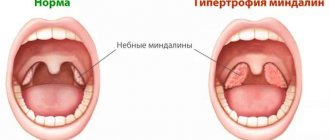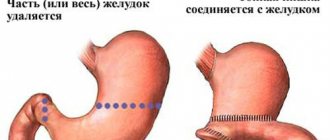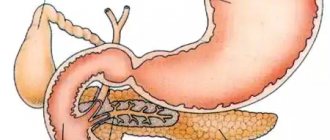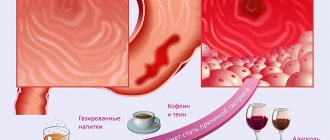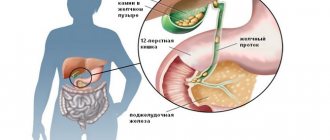Chronic enteritis
This is a disease of the small intestine, characterized by the development of an inflammatory process, atrophy of the mucous membrane of the small intestine and disruption of all functions of the small intestine, primarily absorption and digestion.
Chronic enteritis is not a purely inflammatory disease. Along with elements of inflammation, pronounced dystrophic changes develop in the small intestine, the regeneration of the mucous membrane is disrupted and its atrophy develops.
Causes of occurrence and development
A common cause of the development of chronic enteritis is past intestinal infections: dysentery, salmonellosis, staphylococcal infection.
Nutritional factors are of particular importance: overeating, abuse of spices, spicy foods.
Alcohol abuse. Alcohol can cause damage to the mucous membrane, have a toxic effect on it and contribute to the development of chronic enteritis.
Allergy. Food allergies are of greatest importance. The most common food allergens are cow's milk, fish, chocolate, and eggs.
Exposure to toxic and medicinal substances. Enteritis can develop under the influence of toxic substances - arsenic, lead, mercury, as well as with long-term use of many drugs - non-steroidal anti-inflammatory drugs, cytostatics, and some antibiotics.
Ionizing radiation. The development of this disease is possible with radiation sickness, as well as radiation therapy for malignant tumors of the abdominal cavity and pelvis.
Also among the reasons causing the development of chronic enteritis are previous operations on the gastrointestinal tract, abnormalities in the development of the small intestine, etc.
Enteritis chronic
Etiology: 1) systematic nutritional disorders, abuse of spicy foods and spicy seasonings, poor diet; 2) alcoholism, especially the use of strong alcoholic drinks and their surrogates; 3) industrial intoxication due to violations of safety regulations and chronic poisoning with compounds of lead, mercury, phosphorus, arsenic, etc.; household intoxications, in particular medicinal (with abuse of saline laxatives, long-term uncontrolled use of broad-spectrum antibiotics that can cause intestinal dysbiosis, etc.) and endogenous (with uremia); 4) food allergies; 5) parasitic infestations (giardiasis, etc.), some intestinal helminthiases; 6) radiation injuries (industrial injuries due to violation of safety regulations and as a result of radiation treatment of malignant neoplasms of the abdomen); 7) “accompanying” enteritis with long-term gastritis with secretory gastric insufficiency, chronic pancreatitis, colitis.
Pathogenesis
The most studied mechanisms of the development of the disease: 1) direct chronic damaging effects of the etiological factor on the wall of the small intestine (toxic, irritating); 2) long-term dysbacteriosis, accompanied by irritation and toxic effects of products of abnormal breakdown of nutrients under the influence of enzymes of unusual intestinal flora (organic acids, aldehydes, indole, skatole, methane, hydrogen sulfide, etc.), as well as bacterial toxins on the mucous membrane of the intestinal wall; 3) immunological mechanisms. In some cases, the jejunum (jejunitis) or ileum (ileitis) is predominantly affected.
Symptoms, course
The pain (if it occurs) is usually dull, rarely spastic in nature, and is localized in the umbilical region; here, pain is often noted on palpation of the abdomen and strong pressure (slightly to the left and above the navel - Porges' symptom), pain along the mesentery of the small intestine (in the direction from the navel to the right sacroiliac joint - Sternberg's symptom). Pain when shaking the body or walking can be a sign of perivisceritis. Rumbling and splashing on palpation of the cecum is an important sign of enteritis (Obraztsov’s symptom).
Symptoms
All clinical manifestations of chronic enteritis are divided into general and local symptoms. Local manifestations include the following.
Stool disorders. Diarrhea is most typical for chronic enteritis; stool frequency ranges from 4-6 to 20 times a day. Sometimes there is a urge to defecate after eating, with copious, watery stools. Defecation may be accompanied by general weakness, hand tremors, tachycardia, and palpitations. The amount of feces in chronic enteritis is increased, the feces are liquid or mushy, and contain pieces of undigested food. The presence of mucus and blood in the stool is uncharacteristic.
Flatulence. Most pronounced in the afternoon; accompanied by moderate abdominal pain, which intensifies after eating and decreases after the passage of gas and defecation. The abdomen increases in volume, difficulty breathing is felt.
Stomach ache. With chronic enteritis, abdominal pain is observed quite often. Localized around the navel, in the right iliac region, sometimes spreading throughout the abdomen. With chronic enteritis, the following types of abdominal pain are possible:
- spastic pain is caused by spastic contractions of the small intestine, is paroxysmal in nature, and is localized around the navel. - pain due to flatulence is usually of a constant nature, associated with bloating of the intestine with gases; decrease after defecation. - Mixed pain is caused by a combination of several causes that cause abdominal pain.
Characteristic local manifestations of chronic enteritis are rumbling in the stomach, intolerance to sweet milk, which is manifested by flatulence and diarrhea after taking whole milk and dairy products.
General symptoms are caused by impaired digestion in the small intestine and impaired absorption of the intestine. Patients complain of general weakness, decreased performance, irritability, poor appetite, headaches, and dizziness. Disorders of all types of metabolism develop.
Protein metabolism disorders are manifested by the following symptoms:
- progressive loss of body weight; - muscle atrophy, decreased muscle strength; - decrease in total protein and albumin in the blood.
Fat metabolism disorders:
- loss of body weight, disappearance of subcutaneous fat; - increased excretion of fats in feces; - reduction in blood cholesterol, phospholipids, triglycerides.
Disorders of carbohydrate metabolism are manifested by the following symptoms:
- bloating, rumbling, flatulence, diarrhea. These manifestations are caused by fermentation processes in the intestines. - tendency to decrease blood sugar; - milk intolerance due to lactose deficiency.
Violation of mineral metabolism:
decrease in calcium concentration in the blood. Due to a violation of its absorption in the intestine. Manifested by the following symptoms:
- increased nervous excitability, manifested by cramps of the arms and legs, muscle pain;
- increased bone fragility.
Iron deficiency is of great importance, which is manifested by the following symptoms:
- Iron-deficiency anemia; - dry skin and mucous membranes; - impaired swallowing due to changes in the mucous membrane of the esophagus; - brittle, dry nails, hair loss; - distortion of taste and smell; - decreased iron content in the blood.
Also, with chronic enteritis, there are phenomena of polyhypovitaminosis of varying severity:
— vitamin C deficiency is manifested by bleeding gums, nosebleeds, and frequent colds; — vitamin A deficiency is manifested by dry skin, deterioration of evening and night vision; — vitamin B1 deficiency is manifested by a burning sensation and tingling sensation in the legs, “crawling goosebumps,” weakness in the legs, and decreased tendon reflexes.
There are three degrees of severity of chronic enteritis
I degree – mild form. Characterized by a predominance of local intestinal symptoms, increased fatigue and slight weight loss.
II degree – moderate form. There is a loss of body weight of up to 10 kg, and general disorders, including trophic disorders, become more pronounced.
III degree – severe form. It is not characterized by progressive loss of body weight, dystrophic changes in the skin, nails, hair, anemia, decreased blood pressure, menstrual irregularities in women, erectile dysfunction in men.
Types of enteritis
Enteritis is a gastrointestinal disease
There are several classifications of chronic enteritis. Its types can be distinguished based on the clinical and functional picture, on the morphological changes that this disease entails. But the most important classification is based on the reasons that provoked the development of this pathology. So, according to etiology, the following types of enteritis can be distinguished:
- infectious (bacterial and viral infections);
- helminthic;
- Giardiasis;
- as a consequence of diseases of the gastrointestinal tract;
- as a consequence of liver disease;
- provoked by nutritional reasons (poor nutrition);
- manifested as a result of chemical or mechanical influence
In accordance with the characteristics of distribution, a superficial variety is distinguished, accompanied by dystrophy of enterocytes, and chronic enteritis, which does not lead to atrophy. Based on functional characteristics, one can distinguish a variety with disaccharidase deficiency (when there are failures in membrane digestion), with absorption disorders (when water, electrolytes, proteins, iron, carbohydrates, vitamins, fats are not absorbed); problems with motor skills (both hyperkinetic and hypokinetic types).
The clinical picture of the disease can also occur differently depending on the severity of the disease. The course sometimes has relapses. The disease has several stages, according to which the manifestation of clinical signs can be characterized. This is exacerbation and remission. The disease sometimes has complications (nonspecific mesadenitis, solarium).
Diagnostics
The diagnosis of chronic enteritis is made on the basis of medical history and characteristic clinical manifestations of the disease and is confirmed by additional research methods.
Examination plan for suspected chronic enteritis.
— general blood and urine analysis; — scatological analysis: stool examination; - biochemical blood test with determination of total protein, electrolytes, glucose, urea, creatinine, cholesterol; - examination of duodenal contents; - X-ray examination of the stomach and intestines; — endoscopic examination of the gastrointestinal tract; — Ultrasound of the abdominal organs; - biopsy of the small intestine.
Mizevich Tatyana Vladimirovna
Prevention and prognosis
The disease is not particularly dangerous, but enteritis that is not treated in time can be fatal. Mild to moderate treatment safely returns the patient to normal life within a few days. An advanced degree of enteritis provokes chronic inflammation and atrophy of the small intestine. The inability to digest food leads to death. Other complications include heart failure, kidney and liver disease, and intestinal perforation.
Following simple rules will help you avoid the appearance of enteritis:
- Balanced diet.
- Careful processing of products.
- Compliance with personal hygiene rules.
- Take medications only as prescribed by a doctor.
- Timely consultation with specialists to identify hidden diseases and pathologies.
Symptoms of enteritis
Diarrhea and abdominal pain are the main symptoms of enteritis
The main manifestations of enteritis are considered to be disturbances in absorption and diarrhea that does not completely stop. Diarrhea appears as a result of increased intestinal secretion, increased osmolation of intestinal contents, the development of dysbiosis, and increased speed of movement of intestinal contents. All symptoms of the disease are divided into intestinal and extraintestinal.
Intestinal symptoms
Intestinal symptoms appear depending on the degree of development of the disease. In case of damage exclusively to the upper sections, intestinal symptoms are smoothed out. If the process has spread to the ileum, then the absorption of bile acids is impaired in the distal intestine. When they enter the large intestine, they provoke diarrhea, because under their influence the secretion of sodium, chlorine, and water ions into the intestinal lumen increases.
In addition, motor skills are accelerated. In this case, patients report pain in the iliac region on the right side. Then there is a malfunction of the ileocecal valve, this leads to the reflux of everything that is in the colon into the ileum, from here microbial infection begins in the ileum. If refluxitis lasts a long time, then the body faces problems with the absorption of vitamins, in particular B 12, which ends in corresponding anemia.
Diagnosis of enteritis
Laboratory tests for the diagnosis of enteritis
Laboratory blood test results
When examining blood, anemia is observed in most cases: iron deficiency, folate deficiency, B12 deficiency. A lack of vitamin K and calcium is also detected, the content of serum iron, potassium and chlorine ions in the blood serum is reduced, and the concentration of vitamins is greatly reduced.
Scatological research
Steatorrhea, amilorrhea, and creatorrhoea are detected. For a more in-depth diagnosis, the amount of fat in feces is studied over three days. If, with a normal diet, more than 5 g of fat per day is detected, then this can be regarded as a pathology.
Special research methods
A bacteriological examination of stool is also necessary. After all, the development of microbial flora occurs. Aspiration of the contents filling the small intestine is carried out in order to study microbes and their quantity (normally in intestinal juice the number of microbial bodies should not exceed 104 in 1 ml, with enteritis the number can increase to 109). Cultures are also carried out to identify the pathogenic environment and analysis for Giardia.
To check the ability to absorb substances entering the body, the composition of saliva, urine, feces, and blood is analyzed after the introduction of special marker substances through a probe. Most often, D-xylose is taken for the test, which is administered in an amount of 5 g. Normally, 30% of the substance taken should be excreted in the urine; D-xylose may show a decrease in the amount of excreted substance.
A lactose digestion test may be performed. Lactose deficiency is indirectly indicated by an increase in serum glucose.
X-ray examination, probing
To analyze the changes that have affected the terminal ileum, an X-ray examination of the small intestine is performed. This examination can detect tumors, Crohn's disease, and diverticulosis. In order for the data on the mucous membrane to be as accurate as possible, probe enterography is performed with artificial hypotension with double contrast. This method gives a complete picture of the filling of intestinal loops, the speed of advancement of the contrast agent, the amount of fluid, mucus, the condition of the folds and the uniformity of retention of the substance in them.
Endoscopic examination
This type of examination, accompanied by a biopsy, makes it possible to exclude severe diseases with similar symptoms (tuberculous ileotiphlitis, celiac enteropathy, Crohn's disease). During histological examination, dystrophic changes in enterocytes, moderate villous atrophy, and cellular infiltration of the stroma can be detected.
Types of enteritis
Enteritis is usually classified as:
- due to development (infectious, toxic, drug, parasitic, postoperative, secondary, etc.);
- by localization (inflammation of the jejunum - jeunitis; inflammation of the ileum - ileitis; total enteritis, if the inflammatory process has affected all sections);
- by the nature of morphological changes (without atrophy and with atrophy of varying degrees);
- by severity (mild, moderate, severe);
- In addition, enteritis has acute and chronic forms.
With enteritis, there can be serious fluid loss (1 liter per hour)! Be sure to consult a gastroenterologist at the first symptoms of malaise - it is important to prevent dehydration and other unpleasant consequences!
Treatment of enteritis in adults
The main condition for successful therapy is an integrated approach.
- Diet. Long breaks between meals and constant snacking are not at all beneficial. After all, as soon as food is in the mouth, preparatory work begins in full swing in the small intestine. Disharmony in the regime leads to depletion of enzyme and excretory systems.
- Diet. What good is food that is not digestible? The diet should be gentle and at the same time balanced in all the “positions” necessary for the body.
- Enzyme preparations. If your own enzymes can’t cope, it’s worth getting outside help. But gradually the dose of medications should be reduced. In the “transition period”, you can use the “services” of natural enzymes, which are many herbs and spices, for example, turmeric.
- Restoration of beneficial intestinal microflora.
- Replenishing the lack of vitamins and microelements. In severe cases, this has to be done without going through the gastrointestinal tract (parenterally).
- Physiotherapy. Both ancient and modern medicine have established a relationship between physical activity and the efficiency of the digestive system. Well-known expressions speak about this - “food is absorbed in movement”, “breakfast must be earned”, etc.
- Positive emotions and a healing attitude.
Holistic methods such as acupuncture, qigong therapy, classical and resonant homeopathy, osteopathy, and herbal medicine successfully treat systemic disorders caused by intestinal dysfunction. They are based on the principle of both/and, not either/or. Therefore, if necessary, they can be combined both with each other and with the principles of treatment adopted in classical medicine.
Make an appointment
Treatment of enteritis in children
In case of acute illness, it is important to remember that the child’s body is very sensitive to dehydration. Losing large amounts of water and salts due to severe diarrhea can have very serious consequences. Therefore, you need to make up for the losses as soon as possible - give the child warm water with added salt and sugar and, of course, call a doctor.
Otherwise, in the treatment of childhood enteritis, the general principles discussed below are followed.
Based on psychosomatic relationships, it is worth remembering one more good piece of advice: do not “overfeed” your child with information of any kind. Help him learn it!
